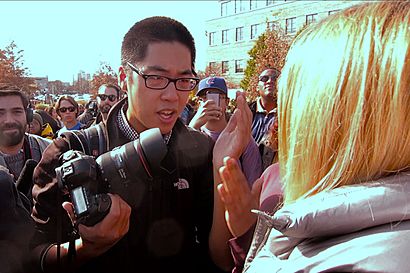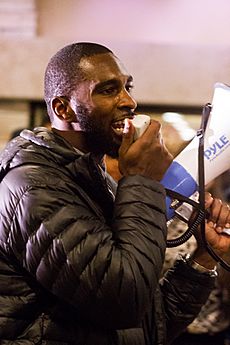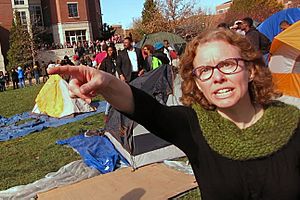2015–2016 University of Missouri protests facts for kids
Quick facts for kids 2015 University of Missouri protests |
|||
|---|---|---|---|

Student photojournalist Tim Tai in a confrontation with assistant director of Greek life Jenna Basler. Tai's attempt to photograph a tented encampment became a major incident in the protests.
|
|||
| Location | |||
| Methods |
|
||
| Lead figures | |||
|
|||
In 2015, students at the University of Missouri held a series of protests. These protests were about issues like race, employee benefits, and how the university was being led. As a result, the president of the University of Missouri System and the head (chancellor) of the Columbia campus both resigned. These changes happened after several important events. These included a hunger strike by a student and a boycott by the university's football team. A student group called Concerned Student 1950 mainly led the movement. Two films, 2 Fists Up by Spike Lee and one by MU student journalists, documented the protests. Some people believe the protests caused fewer students to enroll and led to budget cuts. Others say state government budget cuts were the real reason.
Understanding the Protests
Early Incidents and Diversity Efforts
In 2010, two white students left cotton balls in front of a Black Culture Center. They were arrested and charged with a serious crime. This was seen as a hate crime because cotton balls can remind people of slavery. The students were later found guilty of a minor offense and given probation. In 2011, another student received probation for racist messages written in a dorm. These events led to a program called "One Mizzou" to promote diversity. However, this program ended in 2015 because people felt it had lost its purpose.
On September 12, 2015, the student government president, Payton Head, shared a post on Facebook. He wrote about experiencing prejudice and anti-gay comments on campus. He said people in a truck used racial slurs against him off campus. Head wrote, "I've experienced moments like this multiple times at THIS university." He explained this is why he often talks about being inclusive and respectful. The university's chancellor, R. Bowen Loftin, called the incident "totally unacceptable."
Student Protests Begin
The first student protests started on September 24, 2015. This event was called "Racism Lives Here." Protesters felt that nothing had been done about Payton Head's concerns. On October 1, a second "Racism Lives Here" event took place with 40 to 50 students.
Another incident on October 4 increased racial tensions. Chancellor Loftin, who was traveling, recorded a video message in response. He stated that "Racism and all prejudice is damaging to Mizzou." He urged everyone to work on changing the university's culture. Later that month, the student group "Concerned Student 1950" was formed. The number 1950 refers to the first year the University of Missouri accepted Black students.
On November 3, student Jonathan Butler began a hunger strike. He promised not to eat until the university president resigned. One reason Butler gave was an incident at the school's homecoming parade. Students had stood in front of President Timothy Wolfe's car. The car revved its engine, and Butler was bumped. No police charges were filed.

Butler stated that Mr. Wolfe had many chances to make changes. He felt Wolfe failed to improve the university's culture. Butler also said his involvement in the Ferguson protests influenced his decision.
On November 7, hundreds of future students visited the campus for a recruiting day. Student protesters held a "mock tour." They shared stories of racist incidents that had happened at the university.
On November 8, the university's football players announced a boycott. They said they would not practice or play until President Wolfe resigned. This could have cost the university $1 million if they had to cancel a game. The football commissioner supported the players' actions. The Mizzou Athletics Department also fully supported the team.
The protests received a lot of attention from news media. Some protesters felt the coverage was not accurate. They believed journalists lacked experience with race issues and covered the event as "outsiders."
University Leaders Resign
On November 8, President Wolfe released a statement. He suggested he would not resign. He said he was "dedicated to ongoing dialogue" to solve the complex issues on campus.
However, on November 9, Wolfe announced his resignation. Later that day, Chancellor Loftin also announced he would resign at the end of 2015. He planned to take a research job at the university. The university's governing board sped up his departure to November 11. They gave his duties to Interim Chancellor Hank Foley. Many thought his resignation was due to the protests. But student protesters had not asked him to step down. His resignation was actually due to several issues. Administrators and faculty were unhappy with his leadership style. They also disliked his handling of racist incidents and problems with graduate student health insurance.
The days after the resignations were confusing. Some classes were canceled. There were also reports of threats and suspicious activity on campus.
Hoax Threat Arrest
A student at Missouri University of Science and Technology in Rolla was arrested. He admitted to making a fake threat to the university.
Public Reactions
Melissa Click Incident
After the resignations, a widely reported incident occurred. It involved student photojournalist Tim Tai, who was working for ESPN. He was trying to cover a protest encampment on Carnahan Quad. Tai got into an argument and was physically confronted by students and university staff. This included Melissa Click, a communication professor. Click appeared to grab Tai's camera. She then told another student, Kayla Schierbecker, "Who wants to help me get this reporter out of here?" Other staff members also interfered with Tai. These included Janna Basler and Richard J. "Chip" Callahan. Schierbecker's video of Tai discussing his right to be in a public area became very popular online.
The day after the incident, Tim Tai received support from many people. The student group Concerned Student 1950 handed out flyers. They called the confrontation a "Teachable Moment." They told students to welcome the media to campus to help share the protest story. They also removed signs that had warned media to stay away. Three university employees involved apologized. Melissa Click resigned from her position at the Missouri School of Journalism. On January 25, 2016, Click faced a minor charge related to her behavior. She accepted community service to have the charge dismissed.
Many faculty members supported Click. Some wrote letters to news outlets defending her. In February 2016, a video showed Click shouting at police officers. This happened as they tried to clear students from a road during a homecoming parade. Click said she was sorry for her language. But she also said she had to protect the students from the police.
Later that month, university councils urged leaders to follow rules when dealing with Click. On February 25, 2016, the university's governing board voted to end Click's employment. As a result, the University of Missouri was placed on a censure list by a professors' association. Click later became an assistant professor at Gonzaga University.
KKK Hoax and Campus Safety
On November 10, 2015, Student Body President Payton Head posted an alarming message on Facebook. He later took it back. He wrote that the KKK had been seen on campus. He advised students to stay away from residence hall windows. However, a police major confirmed there was no KKK on campus. He also said the National Guard was not there. Head apologized for sharing false information.
On November 11, 2015, the university stayed open. But many individual classes were canceled due to threats on social media and by phone. During a meeting, university police reported an anonymous threat to the Black Culture Center.
One professor, Dale Brigham, caused controversy. He decided to give a planned exam despite the threats. He said students could skip if they felt unsafe and take a make-up exam. Some students complained he wasn't taking the threats seriously. Brigham apologized and offered to resign. He said he made a mistake and didn't want to cause more harm. However, the university turned down his resignation.
Gus T. Ridgel, one of the first Black students at the university in 1950, was surprised by the racist incidents. He was disappointed by the campus unrest.
Other Protests and Leadership Changes
The events at the University of Missouri inspired protests at over eighty other campuses. These included Ithaca College, Yale University, and Smith College. On November 13, the dean of students at Claremont McKenna College resigned. This happened after students there used similar protest methods, including a hunger strike.
On November 12, the university's governing board chose Michael Middleton as the interim president. Middleton was a law professor and a former deputy chancellor. He was a 1968 graduate of the university and had recently retired after 30 years.
Politicians' Views
During an interview, President Barack Obama praised the protesters. But he warned against protest methods that might stop open discussions. He said there was "clearly a problem at the University of Missouri." He felt it was right for students to protest peacefully against injustices.
Missouri Lieutenant Governor Peter Kinder supported the journalists covering the protests. He called for an investigation into the incident. He said faculty and staff should not choose which rights to respect.
Reporter Access and Enrollment Impact
On February 10, 2016, Concerned Student 1950 held a meeting. It was advertised for "black students and students of color." The group asked all reporters to leave. One reporter, Kayla Schierbecker, refused. She argued the room was a "limited public forum" open to students. She said it was her choice to stay. The group threatened to call campus police. Instead, they ended the meeting and moved to a more private area.
In April 2016, reports suggested the university's reputation was damaged. This was due to how it handled the protests. Alumni and donors were very critical. Donations, especially to the Athletic Department, dropped significantly. Enrollment for new students also fell by about 25%. Some current students considered transferring. Overall, about 2,273 fewer students enrolled in fall 2016. The protests were partly blamed for this decline.
Continued drops in enrollment and funding led to budget cuts and job losses. In May 2017, a university official said enrollment concerns were linked to public perception. By fall 2017, new student enrollment was down 35% compared to two years before. Seven dorms were temporarily closed, and about 400 jobs were cut. The drop in Black student enrollment was 42%, while for white students it was 21%.
Formal Study
In 2018, researchers Adrianna Kezar and Sharon Fries-Britt studied the events. They published a report on how to deal with such complex and emotional incidents.
|



